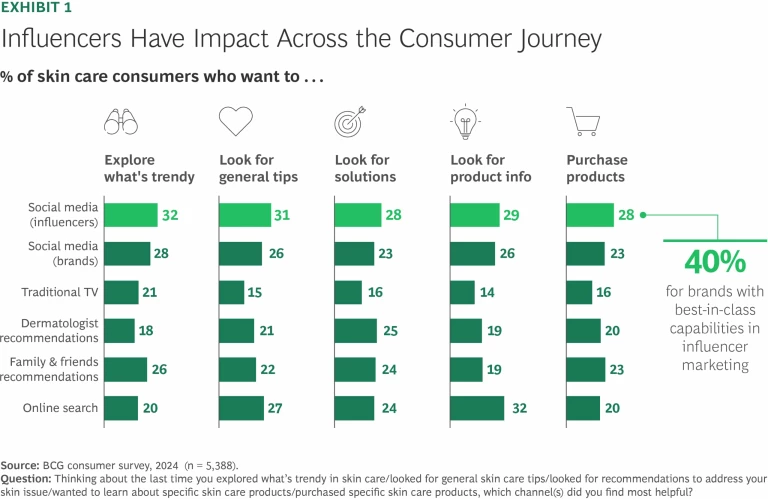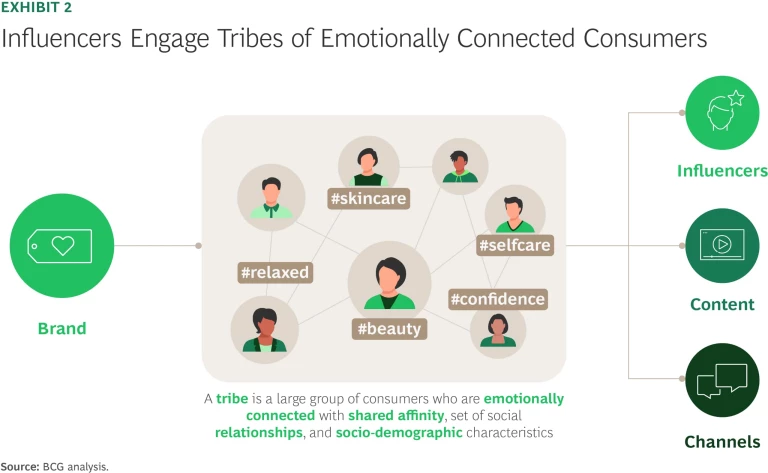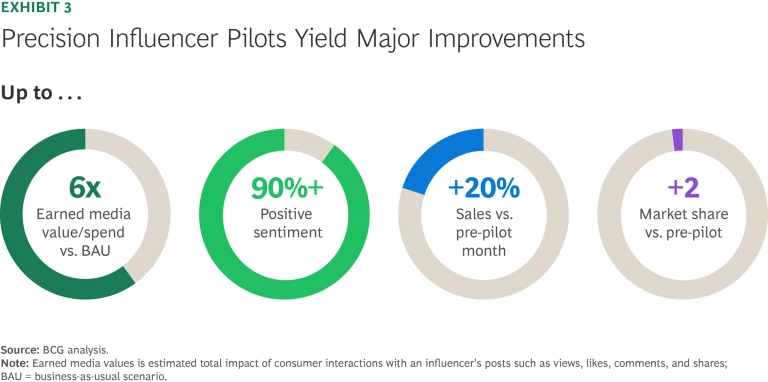Influencer marketing has become a powerful force—reshaping how consumers discover and engage with brands. But as it has gone mainstream, many companies are seeing unclear or disappointing results. The question now is how to create campaigns that break through the noise in an increasingly crowded influencer landscape and make visible impact at scale.
The answer? Get precise. Precision influencer marketing is a consumer-centric approach to influencer marketing that drives tailored customer engagements and measurable outcomes through deep understanding of consumer conversations and preferences. In our work with large brands, we have found that well-executed precision influencer campaigns are six times more efficient at reaching target shoppers than traditional influencer efforts, boosting sales by as much as 20% in the first month.
Delivering such results requires a true transformation. CMOs and their teams must lead their organizations on this journey, ensuring that the company develops the necessary capabilities in areas including talent, technology, and operating models. And they must strike the right balance between enabling hyperlocal, grassroots marketing muscle and providing centralized support, guidance, and know-how. Those who do will successfully elevate their precision influencer marketing efforts to maturity and drive impact at scale.
Subscribe to our Marketing and Sales E-Alert.
Cutting Through the Noise
In today’s hyperconnected world, “influencer marketing” is no longer a buzzword—it’s a strategic imperative. Influencers forge authentic, human connections that traditional advertising simply can’t replicate.
According to BCG research, influencers are the top channel through which consumers explore new brands and products, with a particularly outsized impact in sectors with strong emotional value such as beauty and skin care, fashion, pet care, food and beverage, and childcare. In fact, up to 40% of skin care purchases can be persuaded by social media influencers, especially for brands with best-in-class capabilities in influencer marketing. (See Exhibit 1.)

Delivering on that opportunity, however, is becoming increasingly difficult. Companies report that their influencer campaigns are not connecting with target consumers and that they have limited transparency on the return of their efforts. For brands with strong emotional connections with consumers, the result can be wasted marketing dollars and, in some cases, risks of damaging the brand.
Precision influencer marketing addresses these challenges. It allows companies to identify and understand unique consumer groups that are emotionally connected by similar passions, experiences, and values—what are known in the industry as “tribes.” (See Exhibit 2.)

With that insight, companies can activate influencers who genuinely connect with these groups through tailored messages that are not only heard but embraced. In our recent work with a large consumer brand company, the efficiency of a precision influencer pilot campaign—reflected in earned media value divided by influencer working spend—was six times greater than an earlier traditional campaign. Positive sentiment, sales, and market share, also saw significant improvement. (See Exhibit 3.)

The Precision Influencer Marketing Transformation
Winning in precision influencer marketing isn’t a matter of a one-off campaign but rather a transformation that enables companies to build the right capabilities and muscle to execute. (See Exhibit 4.)

The key enabling capabilities include:
- Operating Model. Companies will need to build out dedicated local influencer marketing teams and create the right mandate and workflows between global, regional, and local teams across different functions.
- Agency Management. The operating model should also clarify which tasks to outsource and establish desired ways of working, following clear service-level agreements with external agencies.
- Data and Social Technology. Teams must be equipped with global access to social tech tools. And companies should build a strong in-house team to deliver on-demand analytics and tooling support.
- Upskilling. Companies should develop structured training programs for both internal teams and external partners including influencer marketing agencies. These upskilling programs will draw on a clear methodology and playbook developed based on lessons learned in pilots and can be tailored to roles and team maturity.
With that foundation in place, companies can build the necessary muscle to execute best-in-class campaigns at scale across five areas:
- Strategy and Planning. Companies should develop a clear strategy for precision influencer efforts, one that is integrated with the work of digital and brand teams. This strategy will determine allocation decisions, spending guidance, and campaign design, with overall campaign management driven by a project management office.
- Consumer Analytics. The key difference between traditional and precision influencer marketing lies in the hyperfocused use of consumer data, including social listening, social platform data and insights, consumer demographics, and behavioral insights. That information allows companies to identify important consumer tribes and develop a comprehensive understanding of who they are, what they like, and what they are passionate about. From there, companies can precisely target those consumers, connecting and engaging with them through influencer campaigns.
- Influencer Management. Companies need the capability to screen and select balanced tiers of influencers. Pulling together the right roster requires more than a quick check of an influencer’s follower count. Companies should instead assess factors like tribe resonance, credibility, content engagement, brand fit, and product relevance. At the same time, they need to develop a system for activating influencers and maintaining a close, productive relationship with them.
- Story and Creative. The best influencer campaigns tell a powerful story. To drive this, companies should develop lean content briefs that include clear themes and tailored messaging that resonates with the target tribes. Companies should also put in place distinct processes for providing guidance to and reviewing the content of influencers.
- Amplification and Measurement. Companies should identify the best-performing content based on clear KPIs and amplify those to maximize campaign performance. And they can learn from those high-performing efforts to optimize future campaigns.
The key difference between traditional and precision influencer marketing lies in the hyperfocused use of consumer data, including social listening, consumer demographics, and behavioral insights.
Putting the building blocks in place for this transformation is a journey. Through our work with a number of leading consumer companies, we have identified four key steps along the way. (See Exhibit 5.)

The effort begins with an assessment of the current state of influencer marketing and the identification of key gaps. Based on this insight, the company can lay the foundation, developing a tailored precision influencer program roadmap followed by a mobilization phase to align teams and set the stage for execution.
The next phase focuses on kickstarting the program through a test-and-learn approach. During this “refine the basics” stage, the company can design and implement insight-driven pilot campaigns. It should also conduct masterclasses to train marketers, both within the company and at outside partner agencies.
As the company’s capabilities evolve, the focus shifts to the “lift maturity” phase. At this stage, the company begins to scale its efforts, increasing the number of precision influencer campaigns and expanding its upskilling programs to enable marketers and agencies to earn next-generation precision influencer certifications.
The final phase in the transformation involves continuous improvement and training to ensure long-term success. In this “sustain impact” phase, the company further scales influencer efforts and closely monitors shifting market dynamics with an eye toward ensuring the adaption of capabilities over time.
To accelerate their progress, companies may also consider establishing a global center of excellence (CoE) at the outset of the process. A CoE can drive the overall transformation and provide guidance to local operational teams including best practices, latest learnings, toolkits, and insights. For example, a CoE can enrich understanding of how to leverage recent trends across the globe in influencer content, with local teams generating suitable hooks based on local context and social and consumer insights. And it can help local teams access the right tools and templates to scale their efforts.
By leveraging the power of precision influencer marketing, brands can elevate their influencer marketing efforts, improve brand perception, and create deeper, more meaningful connections with their consumers. Now is the time for consumer brands—particularly in emotionally driven sectors— to fully embrace this transformative approach.














